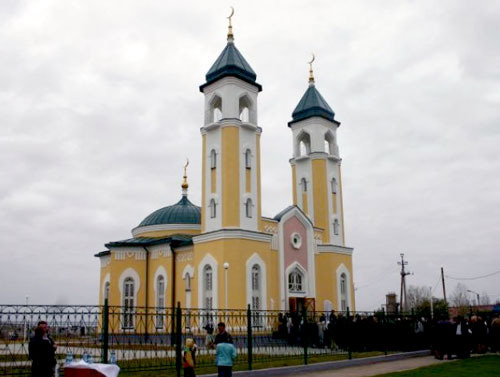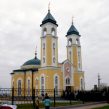
Religious Tensions Grow in Astrakhan Region
Publication: Eurasia Daily Monitor Volume: 10 Issue: 143
By:

Astrakhan is a port city on the lower part of the Volga River and a large military harbor on the Caspian Sea. To the east, Astrakhan region borders Kazakhstan; to the west, the region faces the North Caucasus. Its proximity to that unstable area is a cause of concern for the region’s leadership and security services. That is why Astrakhan region was transferred from the North Caucasian Federal District to the Southern Federal District.
Modern Astrakhan, which is where the powerful Astrakhan Khanate of the Tatars was located, has a population that is only 7 percent ethnic Tatar. However, the region is quickly filling up with settlers from the North Caucasus. The 2010 census found that ethnic Chechens comprised 1 percent and ethnic Dagestanis 2 percent of Astrakhan’s total population.
Strangely, prior to the collapse of the Soviet Union the Salafis chose Astrakhan as their center in the Russian Federation. In fact, in 1990, the first conference of the then-underground Party of Islamic Rebirth movement took place in Astrakhan. This can only be explained by an environment created by local Tatars that is conducive to Salafist ideology. Otherwise, despite its favorable geographic location, Astrakhan is poorly connected to other parts of the country because its transportation routes run mainly via Moscow. (www.verigi.ru/?book=200&chapter=24). Prominent Islamic radicals from the North Caucasus such as Bagaudin Kebedov, Magomed Karachai and Ahmad-kadi Tagaev, among others, were among the most active participants in the conference. In the 1990s, a Salafist community of Mumins (Faithful) existed in the region, headed by Anguta Omarov (a.k.a. Ayub Astrakhanski) from the Dagestani village of Kvanada. The community consisted mostly of ethnic Avars and Dargins (https://astrakhan.ru/history/read/40/).
The mass settlement of Chechens and Dagestanis in the Astrakhan region, which dates back to the 1970s, brought a spirit of protest into the region. The destruction in 1996 of a mosque built by the Muslim community with North Caucasian assistance was an example of the brewing conflict (www.sova-center.ru/religion/news/harassment/places-for-prayer/2006/02/d7231/).
The authorities’ hostile reaction to the construction of mosques in the city of Astrakhan provoked protests by the regional population. One such protest occurred on August 2, 2011, when armed gangs of Russian thugs attacked two mosques in the city—one called Krasnaya, the city’s largest, and the other named after Makhmud Afandi (www.kavkaz-uzel.ru/articles/190228/). The thugs beat up old men, threw stones at the mosques’ parishioners and beat up those who tried to defend their parishes. The authorities did not intervene to stop the ethnic Russian rioters, who shouted slogans against North Caucasians.
There are as many as twenty Tatar mosques in the city of Astrakhan, most of them built in the 19th and the start of the 20th century. There is also a Caucasian mosque in the city (https://islam30.ru/mosques). Overall, there are almost 50 mosques in Astrakhan region (https://xacitarxan.narod.ru/mechetlar.htm), but only the Caucasian mosque dares to issue a public call to prayer (https://golosislama.ru/news.php?id=744).
From 2009 to 2011, many members of Salafist organizations were arrested in the Astrakhan region. The fact that there were several Salafi organizations in the region indicates that the Salafis were divided along ethnic lines. The Salafis of Astrakhan are generally divided into Tatar-Kazakh, Chechen and Dagestani groups. The Salafis attacked the police, carried out bomb attacks, like ones targeting the Interior Ministry’s Academy in the city of Volgograd, the Road Police’s headquarters, and so on. At times, Russians who converted to Islam were the leaders of those organizations (www.aspu.ru/images/File/Izdatelstvo/Kaspiiskii%20region%202(35)%202013/19-26.pdf)—for example, Yuri Avdonin was the leader of Jamaat Tablig and Oleg Marushkin headed one of the units of the Mumin Jamaat.
In May 2013, law enforcement agents in Astrakhan arrested seven people on suspicion of calling for terrorist acts and recruiting residents of the region for participation in a radical Islamic group (https://islam30.ru/news/interview/142-islamoved-andrej-syzranov). In July 2013, the spokesman for the Federal Security Service (FSB) in Astrakhan region, Aleksei Baigushkin, stated that about 60 females in the region were wives or widows of rebels and that law enforcement officials regarded them as potential terrorists who could stage attacks in the region and other parts of the Russian Federation (www.kavkaz-uzel.ru/articles/227902/).
It is hard to draw final conclusions, but it appears that outside of the North Caucasus, Salafist groups in Russia are most powerful in regions that are under the formal leadership of the Central Spiritual Board of Muslims, led by Talgat Tajuddin. It is hard to say whether this relationship is explained by Tajuddin’s extravagant behavior and the reaction of Salafis to it, or the uncritical attitude toward him shown him by authorities in the regions, who still consider him the supreme mufti of Russia. Regional authorities routinely cut short attempts by some local Muslim leaders in Astrakhan to take over mosques and split from the Central Spiritual Board of Muslims headed by Tajuddin. This happened to Mansur Shangareyev, who tried to change the status of the mosque in the village of Bakhtemir. The authorities announced him a “Wahhabi” (a.k.a. Salafi) and fabricated a criminal case against him (www.islamnews.ru/news-1017.html). Thus, the authorities decide which current of Islam a mosque should belong to. This attitude alienates dissident mosques and, in turn, spawns the creation of underground groups that reject the official imams who closely cooperate with the government.
Meanwhile, on the eve of the coming school year, the ethnic-religious council of the Astrakhan region has outlawed the wearing of the hijab in schools. The new rules are effective as of September 1, 2013. The officials astonishingly announced that those who disagreed with their decision were free to leave Astrakhan region for any other place in the Russian Federation (https://islam-astrakhan.livejournal.com/9171.html).
The Iranian factor should also be taken into account, given that Iran is trying to expand its influence and spread Shi’ism (www.ast-news.ru/node/6038). There is one functioning Shi’ite mosque in the city of Astrakhan and another one, Persidskaya (Persian), is undergoing reconstruction.
Therefore, the Astrakhan region can be considered a hotbed of ethnic and religious tensions, and the activities of Muslims in the region appear to be on the rise. The conversion of ethnic Russians to Islam makes the situation especially unpredictable and hard for the authorities to tackle. The situation in Astrakhan vividly shows that the Russian authorities face serious challenges not only in the North Caucasus, but even in regions where ethnic Russians comprise 70–80 percent of the total population. Apart from closely watching the developments in the North Caucasus, Moscow also has to pay increasing attention to ethnically Russian regions of the country.




